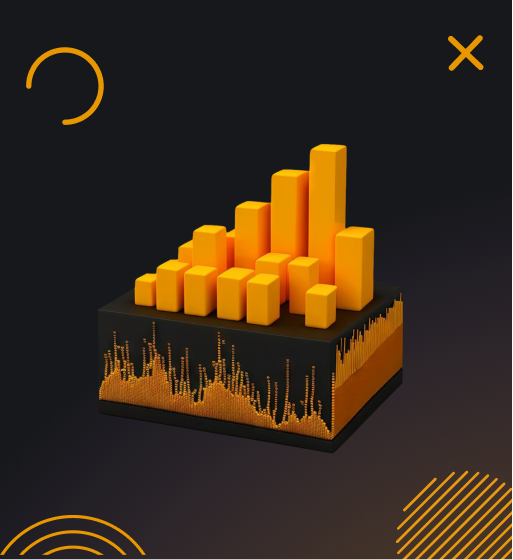
Decentralized finance, also known as DeFi, has transformed how people interact with financial services. One of the most popular uses of DeFi is lending and borrowing cryptocurrencies to earn interest or leverage assets. This beginner's guide will explain everything you need to know about lending and borrowing in the world of decentralized finance.
What is DeFi Lending?
DeFi lending allows cryptocurrency holders to lend their assets to others and earn interest on those loans. It removes the need for intermediaries like banks, enabling direct peer-to-peer lending through smart contracts on the blockchain.
Some key aspects of DeFi lending include:
- Permissionless - Anyone can lend or borrow assets, regardless of identity, credit score or geography.
- Transparent - All lending activity is recorded on the public blockchain ledger.
- Automated - Loans are administered by smart contracts rather than human loan officers.
- Collateralized - Borrowers must put up crypto assets as collateral to receive a loan.
- Uncensorable - No single entity can block users from participating.
In a nutshell, DeFi lending cuts out the middlemen from financial services with transparent, efficient blockchain protocols.
How Does DeFi Lending Work?
The DeFi lending process relies on lending pools and smart contracts:
- Lenders deposit crypto assets into lending pools to supply liquidity.
- Borrowers can then withdraw funds from these pools by putting up collateral.
- An algorithm dynamically sets interest rates based on supply and demand.
- Everything is tracked on the blockchain via immutable smart contracts.
For example, Bob has 1 SOL (the native token of Solana) he wants to put to work. Alice needs a short-term loan to fund a business expense.
Through a DeFi lending protocol, Bob can supply his SOL to a lending pool and immediately begin earning interest from that deposit. Alice can borrow against her 10 SOL collateral to receive a loan in stablecoins, circumventing the need for selling her assets. She pays back the loan to the pool over time with interest.
This creates a transparent free market for money without requiring trust in a bank or government. The rules are simply encoded into smart contracts for all to see.
DeFi Lending vs Traditional Lending
DeFi lending may sound similar to getting a loan from your local bank, but there are a few key differences:
DeFi Lending
- Permissionless - anyone can participate
- Collateral required for loans
- Transparent processes
- Higher interest rates
- Automated through smart contracts
- Nearly instant loan processing
Traditional Lending
- Restrictive lending requirements
- Unsecured loans available
- Opaque processes
- Lower interest rates
- Manual loan processing
- Long wait times
DeFi loans tend to be higher risk but more efficient and accessible to wider range of borrowers. Going through a bank often means lower rates but less transparency, flexibility and speed.
Benefits of DeFi Lending
Decentralized lending offers several advantages over the traditional banking system:
Censorship Resistance
Since DeFi protocols are decentralized across thousands of nodes, no single entity can prevent users from accessing lending services. As long as you have an internet connection, you can lend or borrow assets.
Composability
DeFi lending integrates seamlessly with other DeFi services like decentralized exchanges (DEXs), derivatives, insurance and more. This gives users more financial flexibility.
Transparent Rates
All lending activity takes place on public blockchains. This makes it easy to compare rates across protocols to find the best returns at any given time.
Flexible Collateral
Borrowers aren’t limited to specific collateral types like with bank loans. You can often use lesser-known altcoins and tokens to receive financing in popular stablecoins.
Faster Lending
Forget waiting days or weeks for a lending decision from your bank. DeFi loans can process nearly instantly since smart contracts automate the lending process.
Higher Yields
Supplying assets to DeFi lending pools can be extremely lucrative thanks to network rewards, exchange rates and interest yields. Supply rates often outpace yields from savings accounts.
For crypto holders who don’t want to sell their assets, lending is a great way to unlock liquidity and earn periodic returns. It’s no surprise that billions of dollars now flow through major DeFi lending protocols.
Risks of DeFi Lending
While the benefits may seem enticing, decentralized lending does come with certain risks to consider:
Smart Contract Bugs
DeFi lending relies heavily on smart contracts to automate processes. However, bugs in this code could lead to exploits like flash loan attacks that drain funds from pools.
Impermanent Loss
If asset prices swing widely, liquidity providers may lose money compared to simply holding the assets. This is known as impermanent loss.
Token Depreciation
The value of governance tokens awarded to liquidity providers can heavily fluctuate or even go to zero, resulting in loss of expected yield.
Regulation Uncertainty
Global regulators are still deciding how to oversee various DeFi activities. Future policies could impact lending protocols and yields.
As with all crypto investing, it’s critical to do your own research, spread out capital across protocols and don’t invest more than you can afford to lose. DeFi continues to evolve rapidly so due diligence is a must.
Leading DeFi Lending Protocols
Dozens of platforms now offer decentralized lending and borrowing. Here are a few of the most prominent protocols by total value locked:
Aave - $8.9B
Aave is an open-source, non-custodial liquidity protocol where users can lend and borrow a variety of crypto assets. All loans are overcollateralized. Aave currently supports 16 different cryptocurrencies for money markets.
Pros
- Established protocol with battle-tested code
- Expanding the list of supported assets
- Flash loans capability
Cons
- Risk of bank runs if prices crash
- Complex for crypto beginners
Compound - $5.4B
One of the pioneering DeFi lending protocols, Compound utilizes cTokens to represent shares in asset lending pools. Lenders earn COMP tokens as rewards. Compound helped kickstart the DeFi trend.
Pros
- Earn COMP governance tokens
- Integration with major wallets
- Long track record
Cons
- Lower rates than rivals
- Concentrated whale holdings of COMP
MakerDAO - $3.6B
Maker enables users to lock up crypto as collateral to mint DAI, a decentralized USD stablecoin. This brings stability to DeFi while allowing leverage for traders and hedging during volatility.
Pros
- DAI offers stability amid crashes
- Relatively established history
- Low liquidation penalties
Cons
- Governance token MKR is expensive
- Oracle risks if assets drop fast
For the latest rates and new platforms, check out a resource like DeFi Llama which tracks real-time TVL data.
DeFi Lending Use Cases
Now that you understand the basics, what can you actually do with DeFi lending? Here are some of the most common uses:
Earn Passive Income
Supplying crypto assets to DeFi lending pools allows you to earn attractive interest rates simply by providing liquidity. This creates steady, passive crypto income streams.
Bridge Temporary Cash Shortfalls
If you experience an unexpected expense, DeFi loans offer fast access to fiat stablecoins without selling your assets. This avoids tax headaches.
Leverage Trading Positions
Traders can use flash loans to amplify profits in a trade. Borrowed funds increase buying power for larger positions to capture more upside.
Short Selling Assets
Borrow assets to immediately sell them, then buy back at lower prices later to repay the loan. This lets traders profit from falling prices.
Escape Penalties
Selling staked coins may incur slashing penalties and loss of rewards. DeFi loans allow liquidity without interrupting staking or violating lockup periods.
Arbitrage Opportunities
Funds from flash loans can capitalize on millisecond price discrepancies across decentralized exchanges for nearly instant, low-risk profits.
DeFi lending powers a new generation of boundary-pushing financial products not possible through traditional banks.
The Future of DeFi Lending
While DeFi currently makes up less than 1% of the giant traditional lending markets, the growth trajectory shows no signs of slowing down. In just a couple years, the total value locked in DeFi lending has surged past $80 billion as traders big and small flock to decentralized platforms.
Key DeFi Lending Trends
As adoption increases, here are a few trends shaping the future:
- Aggregators like Notional and Rari Capital make managing DeFi loaning easier through pooled positions across protocols.
- Cross-chain bridges continue expanding DeFi lending to additional blockchains like Solana, Polkadot, and Cosmos.
- Mobile apps improve accessibility for smartphone crypto users who want to tap DeFi opportunities.
- Stricter oversight from global regulatory bodies seems inevitable as DeFi lending scales.
- Further specialization into insurance products, structured products, and other sophisticated offerings.
DeFi lending removes gatekeepers to financial services, allowing open participation and innovation. While risks exist and users must educate themselves, decentralized lending unleashes a wave of empowerment and alignment not possible in closed bank systems. The community-owned nature means DeFi builders and users collectively guide the products and safeguards.
For holding long term crypto investments, leveraging assets, earning yield or accessing quick liquidity, DeFi lending presents a monumental shift in what’s possible in personal finance without centralized control. The technology continues marching steadily forward as developers expand possibilities and real world use cases.
Key Takeaways
- DeFi lending enables peer-to-peer crypto loans through smart contracts, removing intermediaries.
- Anyone can lend assets like BTC and ETH to pools, or borrow stablecoins against collateral.
- Benefits include transparency, flexible terms and interest yield, while risks include smart contract bugs and volatility.
- Leading protocols like Aave, Compound and MakerDAO manage billions in loans.
- Passive income, leverage trading and arbitrage represent common DeFi lending use cases today.
- As the technology matures, DeFi lending could radically transform finance the same way messaging apps disrupted telecoms.
FAQ
Is DeFi lending safe to use?
No investment comes without risks. However, leading DeFi lending protocols incorporate audits, governance structures and insurance funds to help secure user funds. Taking proper precautions available can reduce risks.
What tokens can I supply to DeFi lending pools?
Popular assets for supplying liquidity include stablecoins like USDC, USDT and DAI as well feared crypto assets such as WBTC, WETH, LINK, UNI and AAVE. Most protocols support a range of ERC20 tokens.
Can anyone access DeFi loans?
One of the groundbreaking aspects of decentralized lending is open access for anyone globally. As long as you have the required blockchain wallet and collateral, there are no credit checks or identity requirements.
How do DeFi lending rates compare to banks?
Annual percentage yields for supplying assets on DeFi can range from 3-15% generally, far higher than the less than 1% APY earned through most savings accounts. However crypto markets tend to be more volatile.
Can DeFi loans be liquidated?
Yes, borrowers must maintain a specific loan-to-value (LTV) ratio based on the protocol used, or positions can face liquidation. This ensures the safety of pooled funds.
DeFi lending opens new opportunities in finance - tread carefully but keep an open mind!







